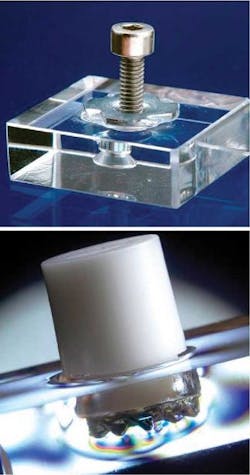MATERIALS PROCESSING: Lasers bond metal and plastic

Industry is still seeing a rise in the use of plastics as a material in integrated technologies and the superior mechanical and electrical properties of metals ensures their place in the mix. But one of the most difficult physical bonds to make is between metal and plastic; anyone with rimless eyeglasses knows how fragile the bond can be. New research from the Fraunhofer Institute for Laser Technology (ILT; Aachen, Germany) has shown a better way to make a stronger bond: with lasers.
Currently, the primary method for bonding metal and plastic is the mold-in technique, in which a component is held in place by a specialized tool during injection molding. But the method requires tight tolerances for positioning and high-precision components, and, depending on the application, does not always result in high-strength bonds. For larger areas, simple glue can be applied, or plastic parts can be fitted with threads to allow a screw fastening. But these methods result in less reliable and weaker bonds.
To address these shortcomings, Jens Holtkamp and his colleagues at the ILT have developed LIFTEC-Laser-Induced Fusion Technology-as a means to improve the process. The method is akin to other, established methods in which metal parts are heated through induction or ultrasonically as a means to melt the surrounding plastic, which cools and results in a form-fitting bond.
LIFTEC is as simple as it is effective; it uses laser light to heat the metal parts. In its simplest application, it exploits the fact that all unpigmented thermoplastics are transparent or translucent. Focusing through the plastic part onto the metal part to be joined causes local melting. The eventual bond can be further strengthened by preparing the metal part with grooves or holes.
Other materials
The method’s strength may be its flexibility. Even temperature-resistant materials like Teflon can be used (see figure). Such nontransparent plastics are joined to metal parts in a slightly different way-rather than transmitting light through the plastic, the metal can be heated laterally, just above the surface of the plastic part, and the metal component is then guided in. Best of all, LIFTEC is not limited to just metal parts; the same approach can be used to join ceramics with plastics.
The method has only recently been demonstrated, but Holtkamp reports one result of note: for a pin diameter of 2 mm, the “pull-out” strength of the bond was shown to be some 700 N.
There is likely to be significant industrial interest in the approach because it requires much less precision in the bonding process than existing techniques. Moreover, using laser irradiation reduces the constraints on heat conductivity of the materials that induction and ultrasonic heating suffer from. “I am confident that LIFTEC has some areas of application where the existing technologies get into difficulties,” says Jens Holtkamp.
The current demonstrations of the technique have used inexpensive diode lasers because there are few constraints on the quality of the laser radiation used-making readily available fiber-coupled diode lasers a sure bet for industrial applications of the approach.
The well-established engineering expertise of the ILT is also coming to the fore to further integrate the technique. “We are also developing machinery adapted to this special process,” Holtkamp says. “So far we use a hydraulic press which is too big and inaccurate for the process. The new machinery is going to be based on an electric drive and can be placed on a desktop. This means that an optician, for example, can put it in his store for an instant joining of the lenses with the frame.”
The method has been patented by ILT and it has already received queries from industry. Before licensing the approach, though, Holtkamp says the group is working to reduce the heating time and studying the strengths of bonds of various geometries that industrial applications will present.